Apple MacBook 13 late 2009 Service Manual
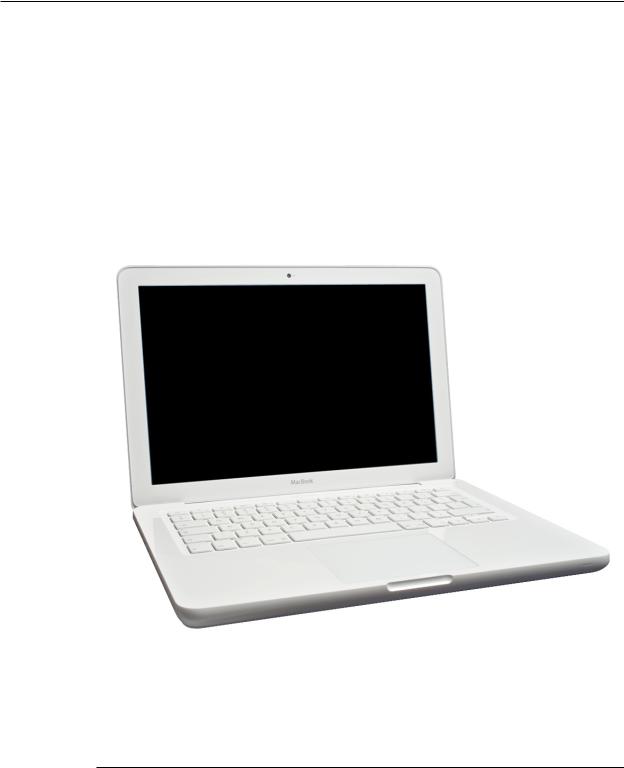
Apple Technician Guide
MacBook (13-inch, Late 2009)
MacBook (13-inch, Late 2009)
MacBook (13-inch, Mid 2010)
Updated 2010-06-15

Apple Inc.
© 2009 Apple Inc. All rights reserved.
Under the copyright laws, this document may not be copied, in whole or in part, without the written consent of Apple.
Every effort has been made to ensure that the information in this document is accurate. Apple is not responsible for printing or clerical errors.
Apple
1 Infinite Loop Cupertino, CA 95014-2084 USA
+ 1 408 996 1010 www.apple.com
Apple, the Apple logo, Mac, MacBook, and Macintosh are trademarks of Apple Inc., registered in the U.S. and other countries.

MacBook (13-inch, Late 2009)
Contents
Updates |
7 |
|
|
|
Updated 15 June 2010 |
7 |
|
|
|
Updated 18 May 2010 |
7 |
|
|
|
Updated 09 April 2010 |
7 |
|
|
|
Updated 01 April 2010 |
7 |
|
|
|
Updated 18 February 2010 |
8 |
|||
Updated 15 January 2010 |
8 |
|||
Updated 8 January 2010 |
9 |
|
||
Updated 2 December 2009 |
9 |
|||
Updated 5 November 2009 |
9 |
|||
Updated 27 October 2009 |
9 |
|||
Apple Technician Guide introduced 20 October 2009 10 |
||||
Feedback |
10 |
|
|
|
Basics
Overview 12
Safety:Battery Precautions 13
Serial Number Location 14
Transferring the Serial Number 15
Note About Images In This Guide 15
Caution About Ordering Replacement Parts 15
Troubleshooting
General Troubleshooting |
17 |
|
|
|
Update System Software |
17 |
|
|
|
Troubleshooting Theory |
17 |
|
|
|
Hardware vs. Software |
17 |
|
|
|
MacBook (13-inch, Late 2009):Functional Overview |
18 |
|||
MacBook (13-inch, Mid 2010):Functional Overview |
19 |
|||
MacBook (13-inch, Late 2009):Block Diagram |
20 |
|
||
MacBook (13-inch, Mid 2010):Block Diagram |
21 |
|
||
Liquid Contact Indicators |
22 |
|
|
|
Common Reset Procedures 23 |
|
|
||
Apple Service Diagnostics |
24 |
|
|
|
Clamshell Service Diagnostic Read Me 25 |
|
|
||

Display Issue:Pixel Anomalies 25
Symptom Charts 27
Startup and Power Issues 27
No Power 27 |
|
|
|
|
|
Intermittent Shutdown 33 |
|
|
|
|
|
No Video/Bad Video 38 |
|
|
|
|
|
Battery Isn’t Recognized or Won’t Charge |
41 |
|
|||
Kernel Panic/System Crashes |
43 |
|
|
||
Battery Run Time Too Short |
45 |
|
|
||
Won’t Run on Power Adapter |
46 |
|
|
||
Noise / Hum / Vibration |
47 |
|
|
|
|
Battery Leaking or Swollen |
50 |
|
|
||
Uncategorized Symptom |
50 |
|
|
|
|
Communications 51 |
|
|
|
|
|
Ethernet Port/Device Issue |
51 |
|
|
||
AirPort/Bluetooth:Defective Wireless Devices |
53 |
||||
No/Poor Wireless Signal |
55 |
|
|
|
|
Wireless Input Device Loses Connection |
56 |
|
|||
Wireless Performance Issue / Slow Connection |
59 |
||||
Wireless Input Device Doesn’t Pair 61 |
|
|
|||
Uncategorized Symptom |
63 |
|
|
|
|
Display 64
Display Anomalies 64
Defective Camera / Built-in iSight Not Operating Correctly 69
Blank / No Video |
70 |
|
|
|
|
Backlight Issue / No Backlight |
71 |
|
|||
Noise / Unstable Flickering |
72 |
|
|||
Mechanical/Physical Damage |
74 |
|
|||
Cosmetic Defects |
74 |
|
|
|
|
Uncategorized Symptom |
74 |
|
|
||
Mass Storage 75 |
|
|
|
|
|
Hard Drive Read/Write Issue |
75 |
|
|||
Hard Drive Not Recognized/Not Mounting |
76 |
||||
Hard Drive Noisy |
78 |
|
|
|
|
Optical Drive Won’t Accept/Reject Media |
79 |
||||
Optical Drive Not Recognized/Device Not Mounting 83 |
|||||
Optical Drive Noisy |
84 |
|
|
|
|
Optical Drive Not Performing to Specs 86 |
|
||||
Uncategorized Symptom |
87 |
|
|
||
Input/Output Devices |
88 |
|
|
|
|
USB Port Does Not Recognize Known Input Devices 88
Built-in Keyboard Does Not Work Properly |
89 |
Specific Keys Don’t Work 90 |
|
Built-in Keyboard Is Not Recognized 90 |
|
Built-in Trackpad Does Not Track Properly |
92 |

Built-in Trackpad Does Not Work 93 |
|
Built-in Speaker Has No Audio 95 |
|
Distorted Sound from Internal Speaker 96 |
|
Uncategorized Symptom |
98 |
Mechanical Issues:Thermals and Enclosure 99 |
|
Reset/Power Button Stuck |
99 |
System Runs Hot 100 |
|
Uncategorized Symptom |
102 |
Take Apart
General Information |
104 |
|
Connector Types on Logic Board |
104 |
|
Tools 107 |
|
|
Icon Legend 108 |
|
|
Temperature Concerns 109 |
|
|
Replacement Steps |
109 |
|
Note About Images In This Guide |
109 |
|
Screw Sizes 109 |
|
|
Bottom Case 110
Top Case Snaps 115
Battery 117
Removal 118
Replacement 119
Trackpad 121
Removal 122
Replacement 123
Hard Drive Bracket 126
Hard Drive 128
Removal 129
Replacement 131
Hard Drive Connector Cable 133
Hard Drive Grommets 134
Memory 136
Removal 137
Replacement 138
Fan 140
AirPort/Bluetooth Flex Cable 143
Rear Vent 145

Rear Speaker |
148 |
|
||
AirPort/Bluetooth Card |
152 |
|||
Optical Drive |
154 |
|
||
Optical Drive Flex Cable |
158 |
|||
Logic Board |
160 |
|
||
Removal |
161 |
|
|
|
Replacement |
|
163 |
|
|
Heatsink 169 |
|
|
|
|
Removal |
170 |
|
|
|
Replacement |
|
172 |
|
|
MagSafe Board |
173 |
|
||
Removal |
174 |
|
|
|
Replacement |
|
175 |
|
|
Display Module |
176 |
|
||
Removal |
177 |
|
|
|
Replacement |
|
181 |
|
|
Top Case with Keyboard |
184 |
|||
Additional Procedures
Trackpad Grounding Strap 187
Views
Exploded Views |
190 |
|
|
Display View |
190 |
|
|
MacBook (13-inch, Late 2009):Main View (side-by-side serial numbers) |
191 |
||
MacBook (13-inch, Late 2009):Main View (stacked serial numbers) |
192 |
||
MacBook (13-inch, Mid 2010):Main View (stacked serial numbers) |
193 |
|
|
External Views 194
Front View 194
Rear View 195
Port View 195
Screw Locations 196
Bottom Case 196
Battery, Rear Vent, Hard Drive Connector Cable 197
Logic Board, Optical Drive, Speaker, Fan, MagSafe Board, Display 198 AirPort/Bluetooth Card and Heatsink 199
Top Case and Trackpad 200

Updates
Updated 15 June 2010
Troubleshooting:
•General Troubleshooting:Resetting the System Management Controller (SMC):Updated text to clarify MagSafe LED behavior; deleted text requiring resetting date and time.
Updated 18 May 2010
Basics
• Overview:Added new model:MacBook (13-inch, Mid 2010)
Troubleshooting:
•General Information:Tools:Updated Apple Service Diagnostic to 3S136 and Apple Hardware Test version to 3A181 MacBook (13-inch, Late 2009) and to 3A199 for MacBook (13-inch, Mid 2010)
•Functional Overview:Added version for MacBook (13-inch, Mid 2010)
•Block Diagram:Added version for MacBook (13-inch, Mid 2010)
•Symptom Charts:Startup/Power Issues:No Power deep dive table:Added power-on pads for MacBook (13-inch, Mid 2010) logic board
Take Apart
•Trackpad:Added alternate trackpad kit part number 922-9551
•Fan:Replaced image showing screws
•Optical Drive:Replaced 4.49 mm screw with part number 922-9516
Views:
•Exploded Views:Added Main View for MacBook (13-inch, Mid 2010)
•Screw Locations:Replaced optical drive screw part number
Updated 09 April 2010
Take Apart
•Top Case Snaps:Added new procedure showing how to replace the three top case snaps
Updated 01 April 2010
Basics
•Caution About Ordering Replacement Parts:Added reminder to enter product serial number in GSX before ordering replacement part
2010-06-15 |
MacBook (13-inch, Late 2009) Basics — Updates 7 |

Troubleshooting
•Symptom Charts:Input/Output Devices:Revised trackpad steps in Deep Dive to refer to trackpad grounding strap procedure
•Symptom Charts:Input/Output Devices:Revised speaker steps in Deep Dive to address right/left speakers on top case
Take Apart:
•Battery:Added alternate part numbers for battery screws
•Trackpad:Added alternate part number for trackpad kit; corrected image for T6 set screw
•Logic Board: Added stacked serial number image; added reminder to enter product serial number in GSX before ordering replacement part
•Top Case:Added reminder to enter product serial number in GSX before ordering replacement part
Additional Procedures
•Trackpad Grounding Strap:Added new procedure to check for or install grounding strap from chassis ground to trackpad; this addresses jumpy cursor movement symptom
Views:
•Exploded Views:Added new notes about the need to refer to GSX for the most accurate parts list; added second Main View for modified part numbers
•Screw Locations:Added alternate part numbers for battery screws
Updated 18 February 2010
Take Apart:
•General Information:Connector Types on Logic Board:Added LVDS cable image and replacement caution to check for gold traces
•General Information:Tools:Added torque driver recommendation for 6 display screws
•Bottom Case:Added new Replacement step 4 to align bottom case notches to clutch
•Rear Vent:Added optional torque driver to Tools; revised step 2 screws, including new 4-mm screw with red locktite and screw ID table; added torque specifications
•Logic Board:Added optional headphone jack to Tools; added new Replacement steps 4-6 to align ports using a headphone jack
•Display Module:Added optional torque driver to Tools; revised Replacement step 1 to include torque specifications
•Top Case with Keyboard:Added replacement note about transferring the trackpad
Views:
•Screw Locations:Added torque specifications for 6 display screws
Updated 15 January 2010
Take Apart:
• Battery:Added battery label reminder
2010-06-15 |
MacBook (13-inch, Late 2009) Basics — Updates 8 |

Updated 8 January 2010
Troubleshooting:
•General Information:Tools:Updated Apple Service Diagnostic to 3S135
Take Apart:
•Trackpad:Added cautions to avoid bending flexures
Updated 2 December 2009
Troubleshooting:
•General Troubleshooting:Added new section“Clamshell Service Diagnostic Read Me”
•Symptom Charts:Startup and Power Issues:Revised for Clamshell Service Diagnostic (CSD) considerations
•Symptom Charts:Communications:Revised for CSD considerations
•Symptom Charts:Display:Revised for CSD considerations
Updated 5 November 2009
Troubleshooting:
•Symptom Charts:Input/Output Devices:Built-In Trackpad Does Not Work:Revised step 2 and step 6 of Deep Dive table to check normal trackpad clicking motion
Take Apart:
•Bottom Case:Added image for screwdriver angle
•Rear Speaker:Modified image for step 4 to emphasize recessed screw
•Optical Drive:Modified image for step 1 to emphasize recessed screw
•Logic Board:Replacement:Added reminder to not remove serial number label
Views:
•Screw Locations:Added heatsink screw length
Updated 27 October 2009
Troubleshooting:
•Symptom Charts:Startup and Power Issues:No Video/Bad Video:Added backlight fuse location to step 9 of Deep Dive table; updated for separate heatsink solution
•Symptom Charts:Display:Backlight Issue/No Backlight:Added backlight fuse location to step 6 of Deep Dive table
•Symptom Charts:Mechanical Issues:Thermals and Enclosure:Updated for separate heatsink solution
Take Apart:
•General Information:Tools:Added thermal grease, cleaning wipes,T8 and #1 screwdrivers
•Trackpad:Updated steps based on trackpad kit contents
•Rear Vent:Tools:Changed from T7 to T8 screwdriver
•Optical Drive:Added image to step 2
•Heatsink:Added heatsink procedure
2010-06-15 |
MacBook (13-inch, Late 2009) Basics — Updates 9 |

•Logic Board (includes Heatsink):Changed title to“Logic Board;”added heatsink replacement reminder
•MagSafe Board:Tools:Changed from #00 to T6 screwdriver
Views:
•Exploded Views:Main View:Added heatsink kit 076-1358; revised logic board reference
•Screw Locations:Added heatsink screws
Apple Technician Guide introduced 20 October 2009
Feedback
We want your feedback to help improve this and future Technician Guides! Please email any comments to smfeedback4@apple.com
2010-06-15 |
MacBook (13-inch, Late 2009) Basics — Feedback 10 |

Apple Technician Guide
Basics
MacBook (13-inch, Late 2009)
© 2009 Apple Inc. All rights reserved.

Overview
The MacBook (13-inch, Late 2009) features a brighter LED-backlit display, a 2.26 GHz Intel Core 2 Duo processor, and the graphics performance of NVIDIA GeForce 9400M integrated graphics. Faster DDR3 memory, a larger 250 GB hard drive, and a new Mini DisplayPort round out some of the performance and feature upgrades.
The MacBook (13-inch, Mid 2010) features a 2.4 GHz Intel Core 2 Duo processor, NVIDIA GeForce 320M graphics, and a 250 GB hard drive
A longer-lasting, high performance, internal battery is no longer customer replaceable.This high-density battery can be safely removed only by an authorized Apple service provider.
For full technical specifications, refer to AppleCare Tech Specs:
http://support.apple.com/specs/
2010-06-15 |
MacBook (13-inch, Late 2009) Basics — Overview 12 |
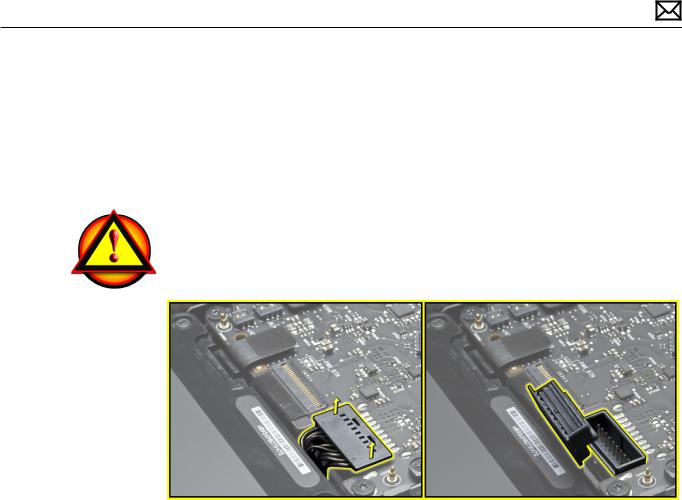
Safety:Battery Precautions
This computer contains an internal-only battery that is serviceable by Apple-authorized service providers only.Tamper-proof screws are employed to prevent customers from attempting to remove it.
WARNING: Every time you remove the bottom case, disconnect the battery cable from the logic board.
WARNING:Because the battery is internal and connected to the logic board by a cable, it MUST BE DISCONNECTED before performing service procedures. If you fail to do so, live current from the battery will short circuit the components and render the logic board and/or LVDS cable unusable.
2010-06-15 |
MacBook (13-inch, Late 2009) Basics — Overview 13 |
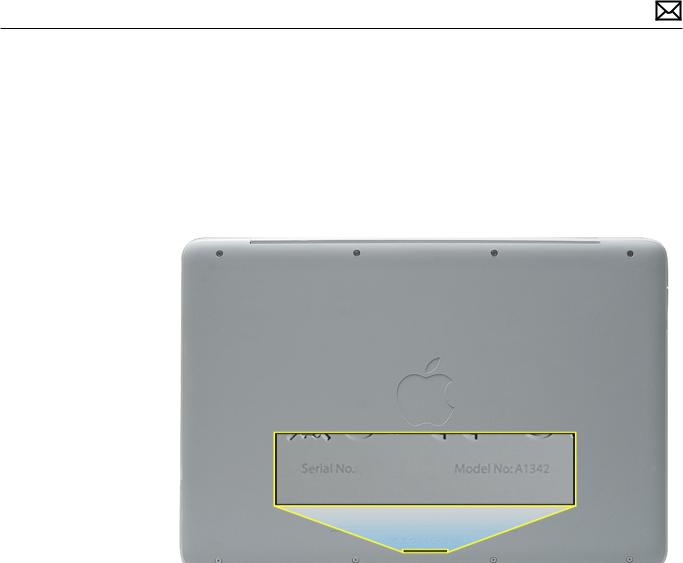
Serial Number Location
Turn over the computer to see the serial number etched on the bottom case front.
2010-06-15 |
MacBook (13-inch, Late 2009) Basics — Serial Number Location 14 |
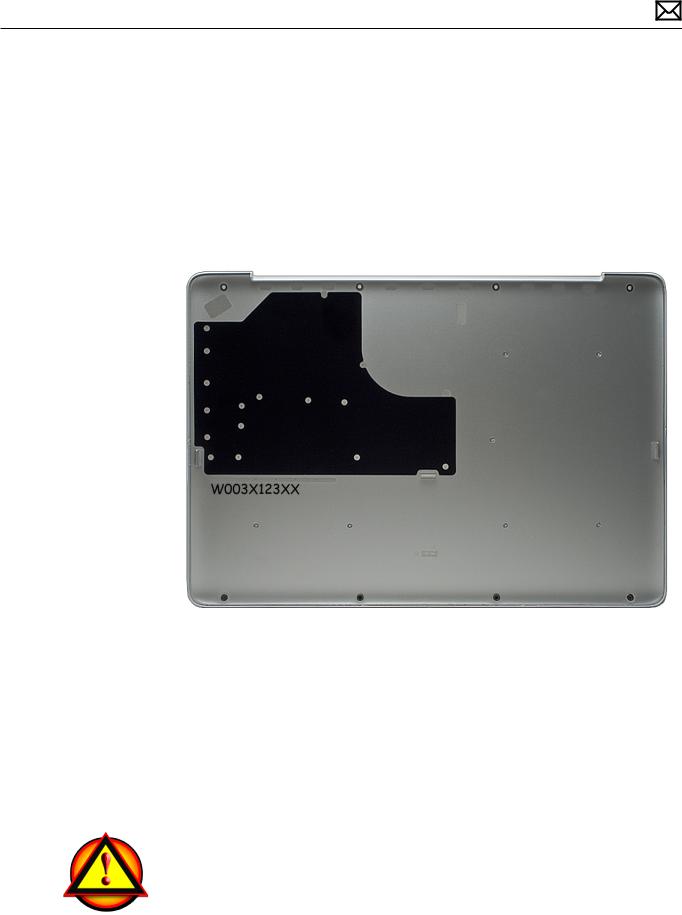
Transferring the Serial Number
When replacing a bottom case, retain the customer’s bottom case until the repair is complete. Before installing the replacement bottom case, use a fine tip permanent marker to write the original serial number clearly and legibly in uppercase box letters directly onto the inside of the new bottom case.
CAUTION:Take great care in deciphering the small typeface of the etched serial number on the bottom case.You might need a magnifying glass to see it clearly. It is imperative that you transfer the correct alphanumeric characters. Keep in mind that Apple serial numbers always use the numbers 1 and 0 instead of the Roman letters“I”and“O.”
Note About Images In This Guide
Because a pre-production model was used for most of the images shown in this guide, you may notice small differences in appearance between the image pictured and the computer you are servicing. However, although the appearance may differ, the steps and sequence are the same unless noted.
Caution About Ordering Replacement Parts
Caution: Some modules have more than one part number due to different product configurations. Before ordering a replacement part, ALWAYS enter the product serial number in GSX to find the compatible part.
2010-06-15 |
MacBook (13-inch, Late 2009) Basics — Serial Number Location 15 |

Apple Technician Guide
Troubleshooting
MacBook (13-inch, Late 2009)
© 2009 Apple Inc. All rights reserved.
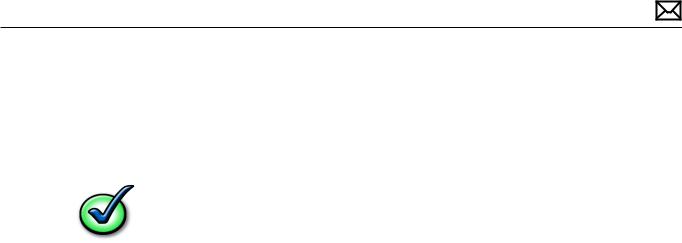
General Troubleshooting
Update System Software
Important: Whenever possible before beginning troubleshooting, ensure the latest software and firmware updates have been applied.
Troubleshooting Theory
For general information on troubleshooting theory, go to GSX and find the Service Training course menu link. From there you can access the Troubleshooting Theory self-paced course.
Hardware vs. Software
For information on how to isolate a hardware issue from a software issue, refer to:
TS1388—Isolating issues in Mac OS X <http://support.apple.com/kb/TS1388>
TS1394—Mac OS X:Troubleshooting installation and software updates <http://support.apple. com/kb/TS1394>
HT2956—Troubleshooting Mac OS X installation from CD or DVD <http://support.apple.com/ kb/HT2956>
For information on how to troubleshoot a software issue, refer to:
HT1199—Mac OS X:How to troubleshoot a software issue <http://support.apple.com/kb/ HT1199>
2010-06-15 |
MacBook (13-inch, Late 2009) General Troubleshooting — Update System Software 17 |
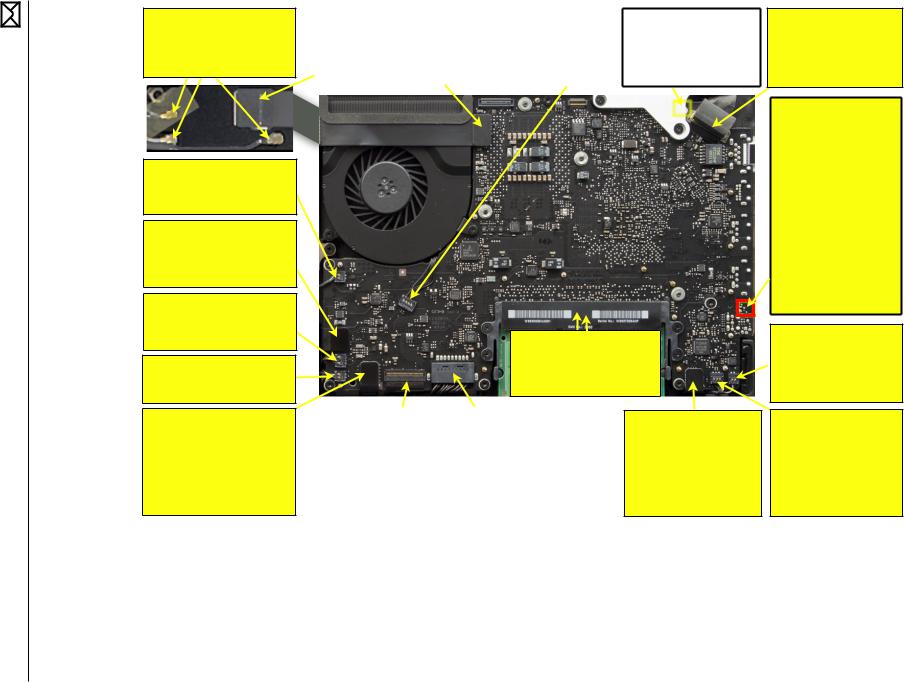
Functional Overview |
to logic board connectors.To more easily view this |
Rotatetheselectpage,command. |
inch,-(13MacBookLate2009): |
diagramthistoReferfor symptoms related |
|
|
: |
|
AirPort/Bluetooth: antennas:
• no /poor wireless reception
Wide-range rear speaker:
• no /bad medium or bass center sound output
SATA optical drive:
•no SATA optical drive visible in System Profiler
•no startup from optical drive
Right speaker
• no/distorted treble output from right top case speaker
Sleep LED:
• no sleep LED status
Trackpad/trackpad button/ thermal sensor:
•no cursor movement
•no click action
•runs slow (trackpad thermal sensor input missing)
AirPort/Bluetooth |
|
Fan: |
|
MagSafe connector |
||
• device(s) not seen in System |
|
• intermittent shutdown |
|
(under logic board): |
||
Profiler |
|
• freezes |
|
• no power on |
||
• no communication with them |
|
• noisy fan |
|
• no battery charge |
||
• no startup (if shorted cable) |
|
|
|
• no LED on adapter |
||
|
|
|
|
|
|
|
|
|
|
|
|
|
|
|
|
|
|
|
|
|
Memory:
•no startup
•freeze or kernel panic
• horizontal video lines
LCD/backlight/camera:
•no video on internal LCD
•no backlight
•no camera
Connector located on other side of logic board:
Sleep sensor:
•no sleep when display closed
•no video on internal LCD, but main monitor on external display when connected (sensor stuck)
Left speaker: no/distorted• treble
output from left top case speaker
Keyboard/power |
|
Battery: |
drive: |
on button: |
|
• not running when on battery |
|
• no power on from |
|
only |
|
keyboard |
|
• no power on (if incorrect model |
|
• nonresponsive keys |
|
of power adapter) |
|
|
|
• X symbol for battery in menu |
|
|
|
bar |
|
|
|
|
|
SATA hard
•no SATA hard drive visible in System Profiler
•no startup from internal hard drive
Microphone: no• internal sound
input level (when internal microphone is selected in Sound Input Preferences)
MacBook(13-inch,Late2009)GeneralTroubleshooting—MacBook(13-inch,Late2009):FunctionalOverview 18
2010-06-15
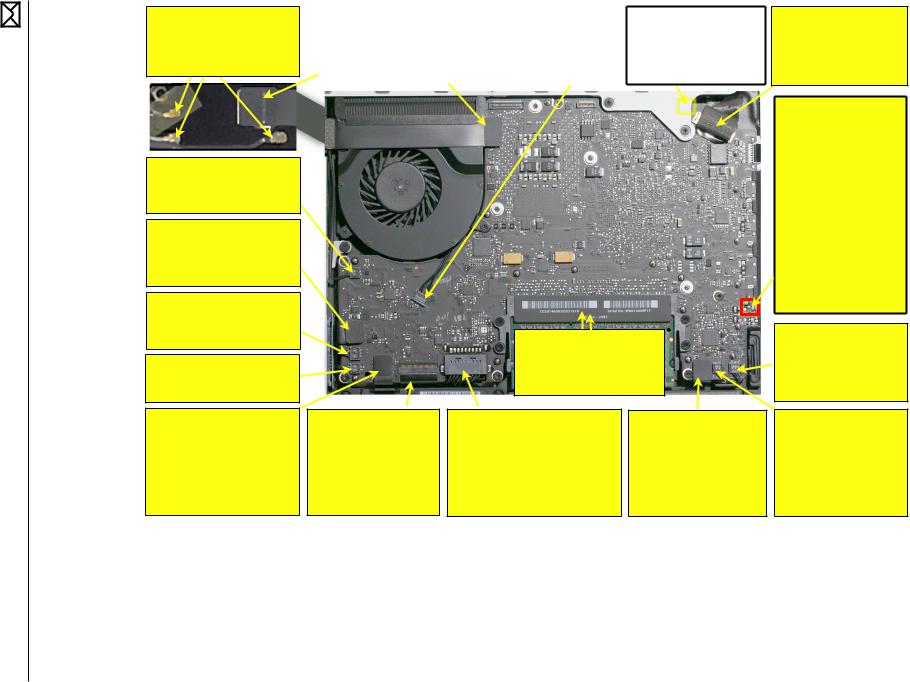
Functional Overview |
to logic board connectors.To more easily view this |
Rotatetheselectpage,command. |
inch,-(13MacBookMid 2010): |
diagramthistoReferfor symptoms related |
|
|
: |
|
AirPort/Bluetooth: antennas:
• no /poor wireless reception
Wide-range rear speaker:
• no /bad medium or bass center sound output
SATA optical drive:
•no SATA optical drive visible in System Profiler
•no startup from optical drive
Right speaker
• no/distorted treble output from right top case speaker
Sleep LED:
• no sleep LED status
Trackpad/trackpad button/ thermal sensor:
•no cursor movement
•no click action
•runs slow (trackpad thermal sensor input missing)
AirPort/Bluetooth |
|
Fan: |
|
MagSafe connector |
||
• device(s) not seen in System |
|
• intermittent shutdown |
|
(under logic board): |
||
Profiler |
|
• freezes |
|
• no power on |
||
• no communication with them |
|
• noisy fan |
|
• no battery charge |
||
• no startup (if shorted cable) |
|
|
|
• no LED on adapter |
||
|
|
|
|
|
|
|
|
|
|
|
|
|
|
|
|
|
|
|
|
|
Memory:
• no startup
• freeze or kernel panic
• horizontal video lines
LCD/backlight/camera:
•no video on internal LCD
•no backlight
•no camera
Connector located on other side of logic board:
Sleep sensor:
•no sleep when display closed
•no video on internal LCD, but main monitor on external display when connected (sensor stuck)
Left speaker: no/distorted• treble
output from left top case speaker
Keyboard/power |
Battery: |
drive: |
on button: |
• not running when on battery |
|
• no power on from |
only |
|
keyboard |
• no power on (if incorrect model |
|
• nonresponsive keys |
of power adapter) |
|
|
• X symbol for battery in menu |
|
|
bar |
|
SATA hard
•no SATA hard drive visible in System Profiler
•no startup from internal hard drive
Microphone: no• internal sound
input level (when internal microphone is selected in Sound Input Preferences)
MacBook(13-inch,Late2009)GeneralTroubleshooting—MacBook(13-inch,Mid2010):FunctionalOverview 19
2010-06-15
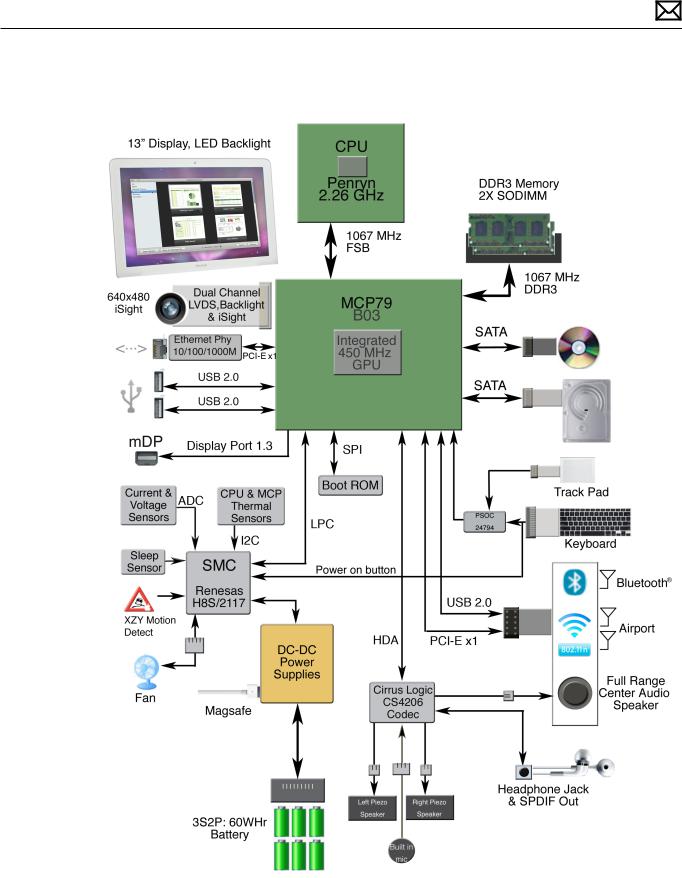
MacBook (13-inch, Late 2009):Block Diagram
Refer to this diagram to see how modules are interrelated.
2010-06-15 |
MacBook (13-inch, Late 2009) General Troubleshooting — MacBook (13-inch, Late 2009):Block Diagram 20 |
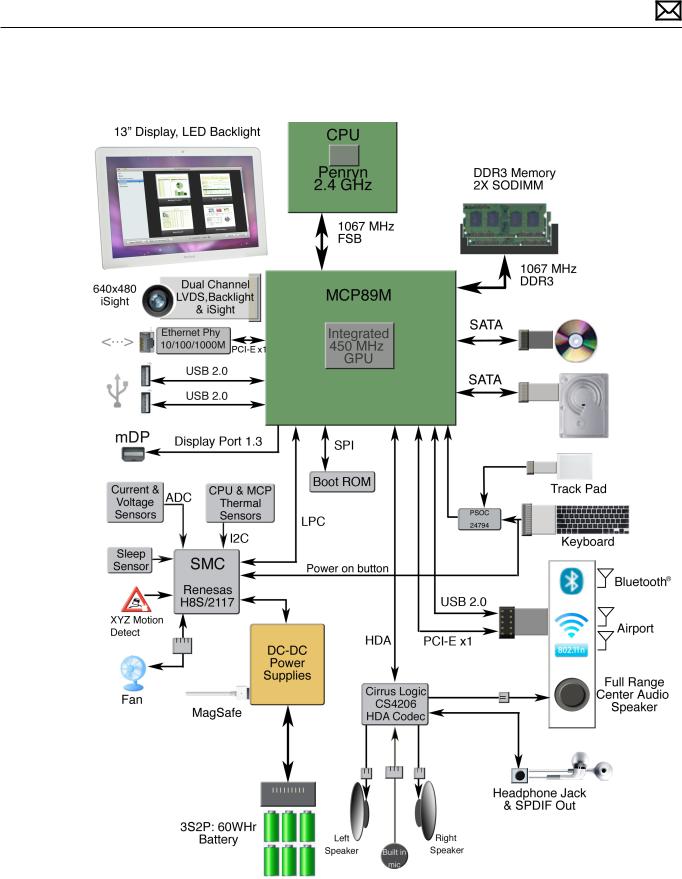
MacBook (13-inch, Mid 2010):Block Diagram
Refer to this diagram to see how modules are interrelated.
2010-06-15 |
MacBook (13-inch, Late 2009) General Troubleshooting — MacBook (13-inch, Mid 2010):Block Diagram 21 |
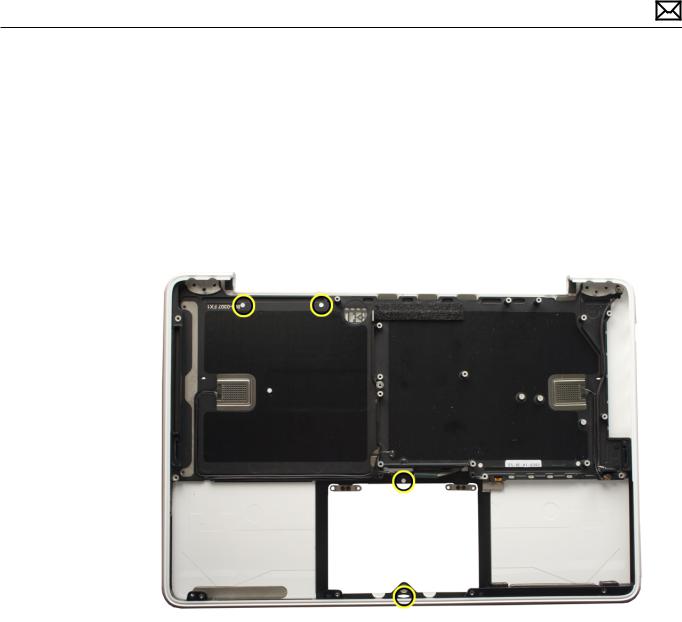
Liquid Contact Indicators
Liquid contact indicators (LCI) have been added to specific locations on current Mac portables to help determine if systems have been damaged by liquid.The sensors are only visible when the bottom case and some of the modules have been removed. Normally represented by small white dots, the LCIs turn red when they have come in contact with liquid, such as an accidental spill.
For more information, refer to Knowledge Base article HT3400: “About Liquid contact indicators (LCI) on portable computers.”http://support.apple.com/kb/HT3400
2010-06-15 |
MacBook (13-inch, Late 2009) General Troubleshooting — Liquid Contact Indicators 22 |

Common Reset Procedures
Resetting the System Management Controller (SMC)
To reset power management via the SMC chip:
1.If the computer is on, turn it off by choosing Shutdown from the Apple ( ) menu.
2.Connect the power adapter to the computer and to a working power source.
3.Important:Use the keys on the left side of the keyboard. On the built-in keyboard, press Shift-Control-Option along with the power button once.
Note: When the LED on the MagSafe connector is orange, resetting the SMC will change it to green for a few seconds, indicating that SMC was correctly reset.
4.Wait 5 seconds and press the power button to restart the computer. Note:If bottom case is removed, you may alternately reset the SMC by disconnecting the power adapter and the main battery, and holding the power button down for five seconds.
For more information:
http://www.apple.com/support
HT1411—Apple Portables:Resetting the System Management Controller (SMC) <http:// support.apple.com/kb/HT3964>
Resetting the Parameter RAM (PRAM)
To reset PRAM,
1.If the computer is on, turn it off.
2.Locate the following keys on the keyboard:Command, Option, P, and R.You will need to hold these keys down simultaneously in Step 4.
Note:If the keyboard does not have an Option key, use the Alt key instead.
3.Turn on the computer.
4.Press and hold the Command-Option-P-R keys.
Important:You must press this key combination before the gray screen appears.
5.Hold down keys until the computer restarts, and you hear the startup chime a second time.
6.Release the keys.
For more information:
http://www.apple.com/support
HT1379—Apple Portables:Resetting the PRAM <http://support.apple.com/kb/HT1379>
2010-06-15 |
MacBook (13-inch, Late 2009) General Troubleshooting — Common Reset Procedures 23 |

Starting Up in Safe Mode
A Safe Boot is a special way to start Mac OS X when troubleshooting.To start up into Safe Mode (Safe Boot):
1.Make sure the computer is shut down.
2.Press the power button.
3.Immediately after you hear the startup tone, press and hold the Shift key.
Note:The Shift key should be held as soon as possible after the startup tone but not before.
4.Release the Shift key when you see the screen with the gray Apple and progress indicator (looks like a spinning gear). During startup, ”Safe Boot”appears on the Mac OS X startup screen.To leave Safe Mode, restart the computer normally, without holding down any keys during startup.
For more information:
http://www.apple.com/support
HT1564—What is Safe Boot, Safe Mode? <http://support.apple.com/kb/HT1564>
TS1884—Safe Boot take longer than normal startup <http://support.apple.com/kb/ TS1884>
Apple Service Diagnostics
Run Apple Service Diagnostics to determine if any of the thermal sensors are malfunctioning. When sensors fail, replace the corresponding part—logic board, battery, or top case. See chart below for correlation between error code and part.
Name |
Location |
TC0D |
Logic board |
TC0P |
Logic board |
Th1H |
Logic board |
TN0D |
Logic board |
Ts0P |
Trackpad flex cable |
TB0T |
Battery |
TB1T |
Battery |
TB2T |
Battery |
TB3T |
Battery |
Refer to Knowledge Base article 112125:Service Diagnostics Matrix for diagnostic software.
2010-06-15 |
MacBook (13-inch, Late 2009) General Troubleshooting — Apple Service Diagnostics 24 |

Clamshell Service Diagnostic Read Me
Isolating video and wireless issues in portable computers can be time consuming and confusing.The Clamshell Service Diagnostic (CSD) is a new diagnostic tool that checks Apple’s latest portable computers for the presence of AirPort, Bluetooth, LCD and Ambient Light Sensor (ALS) to assist you in quickly making a failure determination.
Troubleshooting benefits of using CSD include:
•Quick way (less than 1 minute) to determine whether clamshell-related modules (AirPort, Bluetooth, LCD and ALS) are electrically connected without taking apart the system.
•Results of CSD can help pinpoint if any clamshell cables may need to be reseated to logic board.
•Diagnostic results can help isolate a video or wireless issue to either the clamshell or the logic board, to avoid unnecessary replacements of these components.
CSD checks for the presence of the computer’s:
•AirPort
•Bluetooth
•LCD
•ALS
CSD does not check for the presence of the computer’s:
•iSight camera
•externally connected hardware components (such as USB or FireWire devices)
CSD does not check for issues with the OS X or other software-related problems such as application or extension conflicts.
Display Issue:Pixel Anomalies
When displaying a single color over the screen area, the LCD panel might show one or more pixels that are not properly lit.To determine if the display has an acceptable number of pixel anomalies, follow the steps below:
1.Set the display image to one of the following colors:all-white, all-red, all-green, all-blue, or all-black display. Knowledge Base article 112125:Service Diagnostics Matrix has the LCD Tester Diagnostic Utility that will generate these patterns on the screen.
2.Using a jeweler’s loupe, pocket microscope, or other magnifying device, identify and count each pixel anomaly:
Bright subpixel anomaly = subpixel that is always on
Dark subpixel anomaly = subpixel that is always off
3. The number of acceptable pixel anomalies for this computer is:
Bright |
Up to 3 |
Dark |
Up to 5 |
Combination |
Up to 7 |
2010-06-15 |
MacBook (13-inch, Late 2009) General Troubleshooting — Clamshell Service Diagnostic Read Me 25 |

4. |
If the number of subpixel anomalies exceeds the acceptable number shown above, replace |
|||
|
the LCD panel display assembly. Numbers outside the acceptable range would be: |
|||
|
|
|
|
|
|
|
Bright |
4 or more |
|
|
|
Dark |
6 or more |
|
|
|
|
|
|
|
|
Combination |
8 or more |
|
5. |
If the number of subpixel anomalies is acceptable, explain to the customer that the pixel |
|||
|
anomalies are within specifications, and no repair is necessary. |
|||
Important:Do not release the specifications to customers. Instead, inform them that a certain number of subpixel anomalies are considered acceptable, and these factors apply to all manufacturers using LCD technology—not just Apple products.
When speaking with customers, please use the following explanation:
Active-matrix LCD technology uses rows and columns of addressable locations (pixels) that render text and images on screen. Each pixel location has three separate subpixels
(red, green, and blue) that allow the image to be rendered in full color. Each subpixel has a corresponding transistor responsible for turning the subpixel on or off.
There are typically millions of these subpixels on an LCD display. For example, the LCD panel used in the Apple Cinema HD display is made up of 2.3 million pixels and 6.9 million red, green, and blue subpixels. Occasionally, a transistor does not work perfectly, which may result in the affected subpixel being turned on (bright) or turned off (dark).With
the millions of subpixels on a display, it is quite possible to have a low number of faulty transistors on an LCD.Therefore, a certain number of subpixel anomalies are considered acceptable. Rejecting all but perfect LCD panels would significantly increase the retail price for products using LCD displays.These factors apply to all manufacturers using LCD technology—not just Apple products.
2010-06-15 |
MacBook (13-inch, Late 2009) General Troubleshooting — Display Issue:Pixel Anomalies 26 |
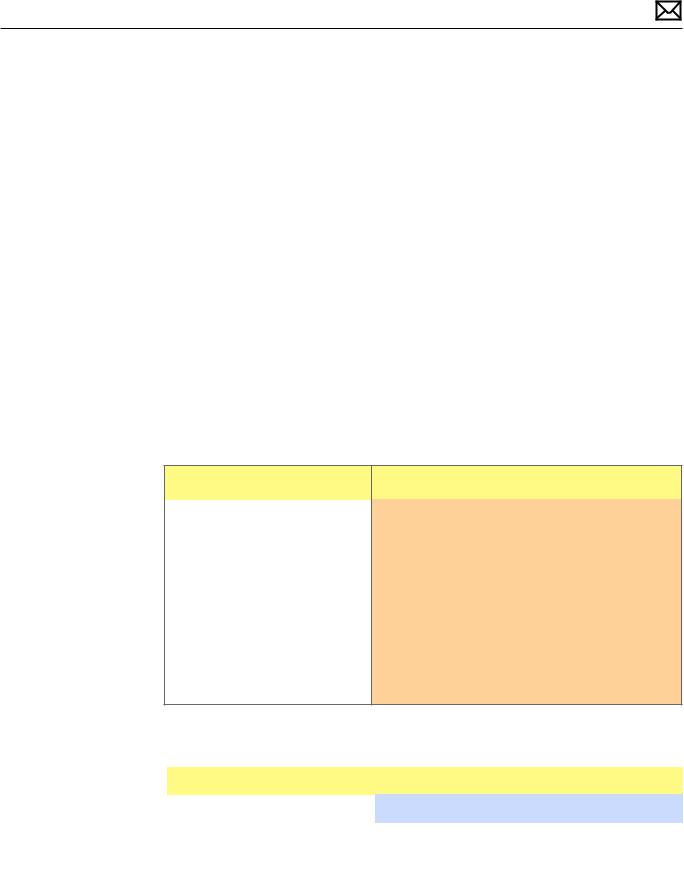
Symptom Charts
Follow the steps in the order indicated below. If an action resolves the issue, retest the system to verify. Note:A compilation of Quick Check tables is available at http://service.info.apple. com/QRS/en/quickreference.pdf.
Note: There is no silk-screen text on final production logic boards.The photos shown with test points are from pre-production units and are solely for reference.
Startup and Power Issues
No Power
Unlikely cause:display assembly, speakers, optical drive, hard drive
Quick Check
Symptom |
Quick Check |
|||
|
|
|
||
No Power / Dead Unit |
1. |
Verify AC power presence with MagSafe LED |
||
• |
No power |
|
indicating on, or in charge state. |
|
• |
No image |
2. |
Verify unit’s power adapter on a known-good |
|
• |
No startup chime |
|
system. |
|
• No fan or hard drive spin |
3. |
Reset SMC. |
||
• No reset sound from optical |
||||
4. |
Run Battery Diagnostic Utility. |
|||
|
drive |
|||
|
|
|
||
•No sleep LED activity
•No light if Caps Lock pressed
•Non-operational
Deep Dive
Check |
Result |
Action |
Code |
|
|
|
|
|
|
1. Test unit’s AC adapter on a |
Yes |
AC adapter OK. Go to step 2 |
|
|
known-good system, and verify |
|
|
|
|
No |
Go to step 3. |
P01 |
||
that it can power and charge |
||||
the battery. |
|
|
|
|
|
|
|
|
2010-06-15 |
MacBook (13-inch, Late 2009) Symptom Charts — Startup and Power Issues 27 |

2. |
Connect known-good and |
Yes |
Go to step 5. |
|
|
correct model of AC adapter |
|
|
|
|
No |
Go to step 9. |
|
|
|
to unit and verify that it can be |
|
||
|
powered on. |
|
|
|
|
|
|
|
|
3. Inspect unit’s AC adapter and |
Yes |
Replace AC adapter |
P01 |
|
|
verify that cable and MagSafe |
|
|
|
|
|
|
|
|
|
connector have no damage |
No |
Clean connector assembly, |
|
|
and are clean and free from |
|
release any stuck pin then |
|
|
defects. |
|
retest AC adapter on a |
|
|
|
|
known-good system. |
|
|
|
|
If damaged, replace AC |
|
|
|
|
adapter for following |
|
|
|
|
symptoms: |
|
|
|
|
-damaged /burnt pins, |
P15 |
|
|
|
|
|
|
|
|
-damaged wire,. |
P16 |
|
|
|
|
|
|
|
|
If still no power go to step 4 |
|
|
|
|
|
|
4. Run Battery & Adapter |
Yes |
Retest AC adapter on unit |
|
|
|
Diagnostics utility on a known- |
|
|
|
|
|
|
|
|
|
good system and verify that |
No |
Replace AC adapter if failing |
P14 |
|
adapter health is good. |
|
Adapter Diagnostics test |
|
|
|
|
|
|
5. |
Reset SMC. Connect known- |
Yes |
Corrupt SMC state prevented |
|
|
good AC adapter and startup |
|
battery management. Issue |
|
|
unit to verify that battery is |
|
resolved with SMC reset. |
|
|
recognized and charges. |
|
|
|
|
No |
Go to step 6 |
|
|
|
|
|
||
6. Verify that battery connector is Yes |
Battery connector has no |
|
|
correctly seated and does not |
visible damage. Go to step 7. |
|
|
have any damaged or bent pin. |
|
|
|
No |
Reseat battery connector and |
|
|
|
|
||
|
|
retest. If physical damages are |
|
|
|
found, replace damaged parts |
|
|
|
and retest: |
|
|
|
-damaged battery, |
P11 |
|
|
-damaged logic board |
M20 |
2010-06-15 |
MacBook (13-inch, Late 2009) Symptom Charts — Startup and Power Issues 28 |

7. |
Unit’s battery may be run |
Yes |
Battery health is reported |
|
|
down, or not recognized. |
|
good . Let battery fully charge |
|
|
Run Battery Diagnostic utility |
|
and retest. If system still does |
|
|
and verify the battery health. |
|
not run from battery only, go |
|
|
|
|
to step 8. |
|
|
|
|
|
|
|
|
No |
Battery health is not reported |
|
|
|
|
good:Replace unit’s battery |
|
|
|
|
according to test failure result: |
|
|
|
|
- for not charging, |
P10 |
|
|
|
|
|
|
|
|
- for not recognized, |
P11 |
|
|
|
|
|
|
|
|
- for a consumed battery |
|
|
|
|
customer will need to |
|
|
|
|
purchase a replacement one. |
|
|
|
|
|
|
8. |
Substitute unit’s battery with a |
Yes |
Replace unit’s battery. |
P11 |
|
known-good one to verify that |
|
|
|
|
No |
Replace logic board. |
M20 |
|
|
system starts on battery. |
|||
|
|
|
|
|
|
|
|
|
|
9. |
Inspect MagSafe port on |
Yes |
Go to step 10 |
|
|
computer for physical damage, |
|
|
|
|
No |
Clean port assembly. Replace |
X03 |
|
|
debris or metal fragments |
|
MagSafe board if necessary. |
|
|
attracted to magnetic |
|
|
|
|
|
|
|
|
|
connector and verify that |
|
|
|
|
MagSafe connector is clean |
|
|
|
|
and free from defects. |
|
|
|
|
|
|
|
|
10. |
Verify adapter status LED turns |
Yes |
MagSafe LED on indicates |
|
|
on green or orange indicating |
|
power is flowing to logic |
|
|
power or battery charge in |
|
board. Go to step 12 |
|
|
progress. |
|
|
|
|
A green LED can indicate a |
No |
Go to step 11 |
|
|
full battery or a battery not |
|
|
|
|
recognized. |
|
|
|
|
|
|
|
|
11. |
Reset SMC.Verify that system |
Yes |
Corrupt SMC state prevented |
|
|
powers on after SMC reset. |
|
system power. Issue resolved |
|
|
|
|
with SMC reset. |
|
|
|
|
|
|
|
|
No |
Go to step 12. |
|
|
|
|
|
|
2010-06-15 |
MacBook (13-inch, Late 2009) Symptom Charts — Startup and Power Issues 29 |
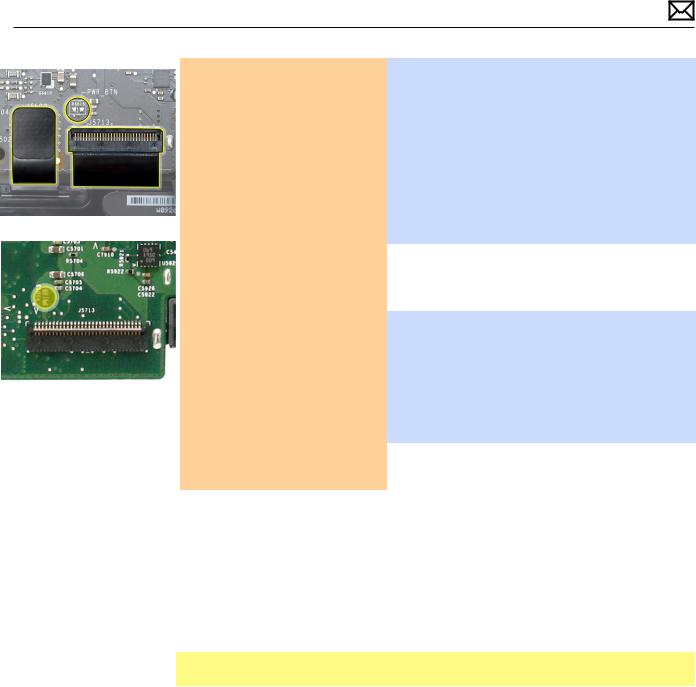
12. Reseat the keyboard flex cable |
Yes |
Power on key works fine, issue |
|
to logic board. A disconnected |
|
resolved. |
|
keyboard or a stuck/open |
|
|
|
power-on key can disable |
|
Power on key works when |
|
system powering on. If power |
|
keyboard cable is reseated. |
|
button does not work, use |
|
|
|
|
Power on key appears to |
|
|
jeweler’s flatblade screwdriver |
|
|
|
to short the Power On pads on |
|
be stuck, had to remove |
|
logic board (see image, left) |
|
keyboard cable to power on. |
|
to power up the logic board. |
|
Replace top case for stuck |
|
If power-on key is stuck, |
|
power on key. |
K05 |
keyboard flex cable might |
|
|
|
No |
No logic board power on |
|
|
need to be disconnected |
|
||
|
when shorting power-on |
|
|
before shorting pads.Verify |
|
|
|
|
pads. Go to step 13 |
|
|
that system powers on. |
|
|
|
|
|
|
|
|
|
|
|
13. Remove logic board and verify |
Yes |
Replace MagSafe board; |
X03 |
that the MagSafe connector |
|
retest. |
|
is correctly connected |
|
With replaced MagSafe board |
|
underneath logic board. |
|
|
|
|
and known-good AC adapter |
M01 |
|
|
|
||
|
|
connected, short Power On |
|
|
|
|
|
|
|
pins. If system still does not |
|
|
|
power on, replace logic board. |
|
|
|
|
|
|
No |
Reseat MagSafe connector on |
|
|
|
logic board and retest. |
|
|
|
|
|
Won’t Start Up
Unlikely cause: display assembly, speakers, fan, camera, microphone
Quick Check
Symptom |
Quick Check |
||
|
|
|
|
Power but No start up |
1. |
Reset SMC. |
|
• No startup chime, some video |
2. |
Verify startup process passes initial memory |
|
activity, Apple logo, startup |
|||
|
checks – no beep errors or flashing sleep LED |
||
spin dial |
|
indicators. Display activity is starting up. |
|
• Startup chime with possible |
3. |
Clear PRAM.Verify starts up from user drive. |
|
beep tones. |
|||
4. |
Connect known-good external bootable device |
||
• Fan, hard drive spin or optical |
|||
|
and press Option (Alt) key during startup; then |
||
drive reset sound |
|
||
|
select external startup device to bring up system |
||
• Sleep LED is on , blinking or |
|
||
|
for diagnostics. |
||
went out |
5. |
Verify presence and status of user hard drive. Use |
|
• Caps Lock LED toggles when |
|||
|
Disk Utility to repair drive and file permissions. |
||
pressed |
|
||
|
|
||
|
|
|
|
2010-06-15 |
MacBook (13-inch, Late 2009) Symptom Charts — Startup and Power Issues 30 |
